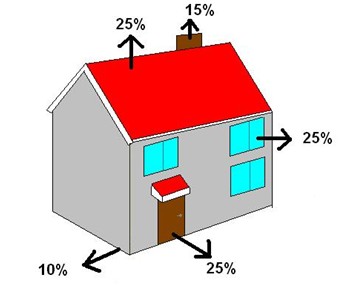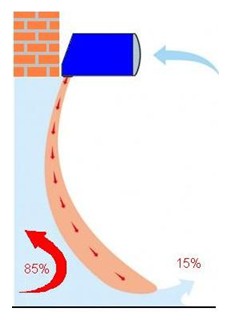
- < 1|2 >
THERMOMODERNISATION FUNDS
TECHNOLOGIES OF THERMOMODERNISATION
Figure 21 shows typical heat losses trough different parts of the building. As can be seen every component presents similar losses on average. Thus it is positive to perform a comprehensive thermomodernisation.

The most commonly used thermomodernisation technique is enhancing walls and roofs insulation. There are two main methods of walls insulation. First one is called light wet method and it is about sticking to the wall an insulation covering using adhesive mortar. Then the insulation made usually from polystyrene or mineral wool is covered by daub. The other method is light dry method. Here an insulation covering have to be mechanically connected to the wall by nails, studs, bolts or pegs. Then the insulation is consequently covered by bars and elevation. First method has very simple and light construction. However it requires to be placed during proper seasons, rain or snow makes it infeasible to install. The other method is more stable and can be installed at any time of year. However it requires more work since its construction is more complex. Thermomodernisation of roofs is very similar to the thermomodernisation of walls. The difference is that roofs have to be insulated from the inside and they need any kind of vapor barrier to prevent vapor from condensing in the insulation covering.
Another technique in thermomodernisation is a replacement of aged windows and doors. None of the norms before 1982 included any rules about windows or doors h coefficient (table 5). This resulted that today many of those aged windows are leaky and their h coefficient equals 2,8 [40]. New hermetic, windows have h equaling 1,3 thus knowing that an average heat loss through the windows is about 15% (Figure 20) a replacement of aged windows significantly reduces the energy losses.
In some buildings such as shopping centers, offices or stores the doors are usually large and opened very often. This results in augmented thermal energy losses. To avoid that situation it is vital to install an air door (Figure 22). Air doors also known as air curtains are appliances which separate two spaces, usually at the entrances. Their task is to keep the insects, dust and dirt away from inside as well as avoid the heat loss. Air doors are usually installed on the top of the doors and they blow warm air with high speed directly to the ground which creates an “air curtain”.

Ventilation is another area where energy losses can be reduced. However ventilating process can be stopped or even working incorrectly as a result of thermomodernisation which is invalid. When buildings walls are insulated, doors and windows are hermetic a building seems to be fully thermomodrenised. However too hermetic windows cause no air circulation in the building. This problem occurs when natural ventilation is implemented. To reduce heat losses and simultaneously improve ventilating process mechanical or forced ventilation systems should be implemented including heat exchangers.
One of the methods of thermomodernisation is an installation of renewable or cogeneration energy source. The most commonly used renewable energy sources are heating pumps and solar collectors. Heating pumps are devices which forces the heat to move from a cooler place to the hotter. Heating system equipped with heating pumps requires two tanks. The first one is a cool tank from where the heat is pumped and it is usually located a few meters below the ground because that place provides roughly constant temperatures during the whole year. The other tank is where the heat is pumped to and it is a system of heaters within the building. Now the heating pump compresses the factor from the cool tank and guides it to the hot one. The factor which can be air, chlorofluorocarbon or ammonia gains heat when compressed. The hot factor is used to heat the building and then expanded in the cooler tank. The other commonly used renewable energy sources in thermomodernisation are solar collectors. There are many kinds of solar collectors depending on the construction and used factors. However their common assumption is to heat the factor which can be air, water or glycol using the collectors which are heated by the solar power.
- < 1|2 >
-
Definition of energy conservation and demand side management|
Technologies|
Financial funds|
Legislative and normative issues|
Data base
Copyrights © Arkadiusz Mysiakowski
